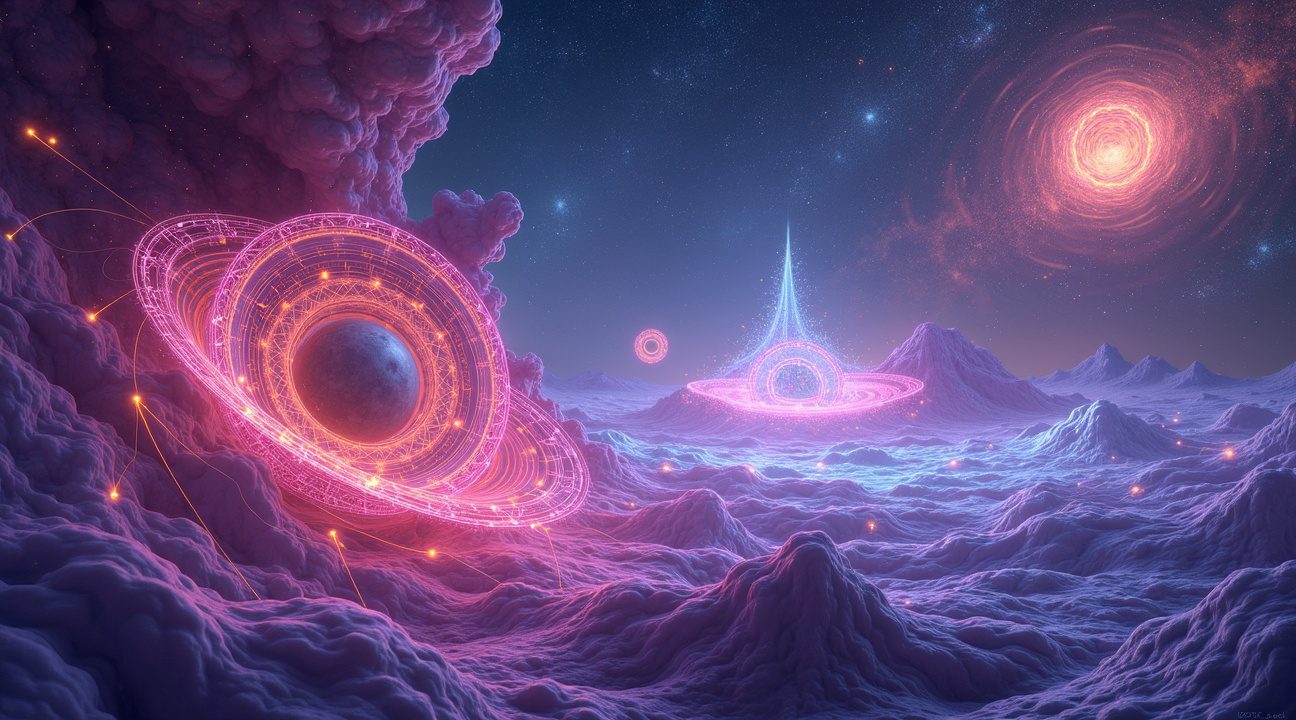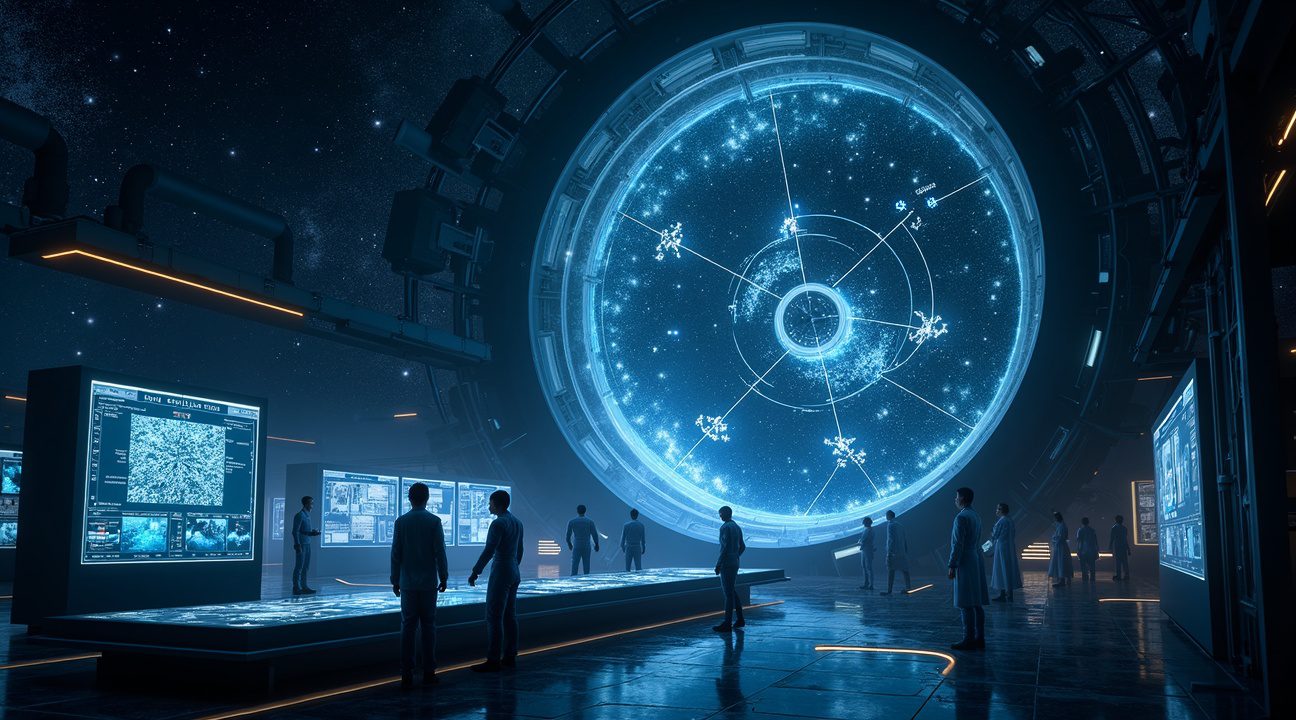M-Theory and the Hidden Dimensions of the Universe
M-theory suggests that our universe contains 11 dimensions—10 spatial dimensions plus time—fundamentally challenging our everyday experience of reality’s four-dimensional structure.
The seven extra spatial dimensions remain hidden from perception and experimentation because they are compactified at extraordinarily small scales. According to theoretical models, these dimensions are curled up in intricate geometries that exist far beneath the detection capabilities of today’s most advanced scientific instruments.
Key Takeaways
- M-theory unifies five previously competing string theories by interpreting them as different mathematical expressions of a single 11-dimensional framework, addressing the confusion caused by having multiple, seemingly unrelated string theories.
- The seven hidden spatial dimensions are compactified at the Planck scale (approximately 10-35 meters), which necessitates technology capable of producing energies nearing 1019 billion electron volts—currently beyond our means.
- Advanced mathematical tools such as quaternions, octonions, and brane theory are essential for modeling interactions and structures that occur within high-dimensional spaces described by M-theory.
- The geometry of compactified dimensions—like Calabi-Yau manifolds and G2 spaces—plays a critical role in defining observable features of our universe, including particle types, masses, force interactions, and the existence of three particle generations.
- M-theory poses a significant challenge in terms of testability since it currently lacks direct experimental support, raising philosophical and methodological concerns about whether such frameworks can be considered scientifically valid.
For more on the shape of the hidden dimensions, you can read about Calabi–Yau manifolds and their mathematical importance in string theory and M-theory research.
Why Our Universe Might Actually Have 11 Hidden Dimensions
I find M-theory’s proposition of 11 dimensions absolutely fascinating because it fundamentally challenges how we perceive reality. Most people experience only four dimensions daily: height, width, length, and time. However, M-theory suggests our universe contains seven additional spatial dimensions that remain hidden from direct observation.
The Mathematical Foundation Behind 11 Dimensions
M-theory represents an evolution beyond traditional string theory, which operates within a 10-dimensional framework. While string theory provided groundbreaking insights into particle physics, M-theory extends this concept by adding one more dimension to create an 11-dimensional structure. This expansion isn’t arbitrary—mathematical consistency within the theory demands exactly 11 dimensions for the equations to work properly.
The distinction between these dimensions proves crucial for understanding the theory. M-theory includes 10 spatial dimensions plus 1 time dimension, creating the complete 11-dimensional spacetime framework. Unlike the spatial dimensions we navigate through daily, time functions differently as a dimension, allowing movement in only one direction under normal circumstances.
Why We Can’t Detect the Hidden Dimensions
The seven extra spatial dimensions remain invisible to us because they’re compactified—essentially curled up so tightly that they exist at scales far smaller than current experimental equipment can detect. I think of these dimensions like looking at a garden hose from a great distance. From far away, the hose appears one-dimensional (just a line), but up close, you can see it has width and circumference—additional dimensions that weren’t apparent from afar.
Several key factors explain why these dimensions stay hidden:
- The compactification occurs at the Planck scale, approximately 10-35 meters
- Current particle accelerators lack the energy needed to probe such tiny scales
- The dimensions might be curled up in complex geometric shapes called Calabi-Yau manifolds
- These hidden dimensions could be wrapped around themselves in ways that make them effectively invisible to three-dimensional observations
The concept of branes (short for membranes) plays a vital role in M-theory’s dimensional structure. Our familiar matter and forces might be confined to a three-dimensional brane floating within the larger 11-dimensional space. This confinement would explain why we can’t directly access or observe the extra dimensions, even though they influence the fundamental properties of our universe.
Compactification represents one of M-theory’s most elegant solutions to the dimension problem. Rather than requiring these extra dimensions to be infinite like our observable spatial dimensions, the theory proposes they’re finite and curled up. This curling happens in such intricate ways that the dimensions fold back on themselves, creating closed loops at microscopic scales.
The implications of these hidden dimensions extend far beyond theoretical curiosity. These extra dimensions could influence the strength of fundamental forces, the masses of particles, and even the overall structure of spacetime itself. Some physicists speculate that gravity might leak into these extra dimensions, which could explain why gravitational force appears weaker than other fundamental forces in our observable universe.
Understanding what is the 9th dimension helps bridge the gap between our familiar four-dimensional experience and M-theory’s complete 11-dimensional framework. Each additional dimension adds new possibilities for how particles and forces might interact in ways we’re only beginning to comprehend.
The mathematical elegance of M-theory’s 11-dimensional structure continues to drive research in theoretical physics. While we can’t yet directly observe these hidden dimensions, their theoretical existence offers potential explanations for some of the universe’s greatest mysteries, from dark matter to the hierarchy problem in particle physics.
How M-Theory United Five Competing Physics Theories Into One
Before M-theory emerged, physicists found themselves wrestling with a puzzling situation. Five distinct string theories had been developed, each mathematically consistent yet apparently separate: Type I, Type IIA, Type IIB, heterotic SO(32), and heterotic E8 × E8. Each superstring theory seemed to describe different aspects of fundamental physics, creating what many considered an embarrassing abundance of options for a theory that was supposed to provide a single, unified description of nature.
The Discovery of String Duality
M-theory transformed this apparent chaos into elegant unity through the revelation of string duality. These mathematical connections demonstrated that the five competing theories weren’t actually different theories at all. Instead, each represented a different approximation or limit of one more fundamental 11-dimensional framework. String duality revealed that physicists had been looking at the same underlying structure from different mathematical perspectives.
This unification solved a critical problem that had long frustrated researchers. Previously, physicists could only explore certain regimes of string behavior — specifically, weakly coupled scenarios where mathematical calculations remained manageable. Strong coupling regimes, where the interactions between strings become intense, had been largely inaccessible because the mathematics became intractable. Dualities changed this limitation entirely by showing that a strongly coupled description in one theory corresponds to a weakly coupled description in another.
The Power of the 11th Dimension
The key to these transformations lies in how the 11th dimension behaves. By compactifying this extra dimension — essentially curling it up to microscopic size — or expanding it, physicists can move between different string theory descriptions.
- When the 11th dimension is compactified on a circle, M-theory reduces to Type IIA string theory.
- Different compactification schemes produce the other string theories, revealing them as various faces of the same underlying structure.
This dimensional flexibility opens up previously impossible investigations. Strong coupling regimes in heterotic string theories, for instance, can now be studied by examining their dual descriptions where the coupling is weak and calculations become feasible. The mathematical framework extends beyond our familiar dimensions, allowing these transformations to occur naturally.
Type IIA and Type IIB string theories, which had seemed fundamentally different, are revealed through duality to be related by dimensional transformations. Similarly, the two heterotic string theories — SO(32) and E8 × E8 — connect to the other theories through various duality relationships. Each theory captures different physical scenarios, but all emerge from the same 11-dimensional foundation.
The unification achieved by M-theory represents more than mathematical elegance. It provides physicists with a complete toolkit for exploring string behavior across all coupling regimes. Where one description becomes difficult to work with, researchers can switch to a dual description where the physics becomes more transparent. This flexibility has opened new avenues for understanding black holes, cosmology, and the fundamental nature of space and time.
M-theory’s success in uniting these five theories demonstrates the power of thinking beyond conventional dimensional boundaries. The 11-dimensional framework doesn’t just connect existing theories — it reveals that apparent diversity in fundamental physics may actually reflect our limited perspective on a deeper, more unified reality.
https://www.youtube.com/watch?v/xpAvcGcEc0k
The Mathematical Systems That Describe Objects in Multiple Dimensions
Understanding complex objects across multiple dimensions requires sophisticated mathematical frameworks that can capture their intricate properties and behaviors. Below is an exploration of the key mathematical systems that physicists and mathematicians employ to describe these fascinating multidimensional entities.
Quaternions and Their Role in Three-Dimensional Descriptions
Quaternions serve as the foundation for describing complex orientations in three-dimensional space through a four-variable system. These mathematical constructs account for yaw, pitch, roll, and magnitude, providing a complete description of how objects move and rotate in our familiar three-dimensional world. Quaternions offer several advantages over traditional rotation matrices:
- They eliminate gimbal lock problems that plague other rotation systems
- They require less computational power for complex rotational calculations
- They provide smoother interpolation between different orientations
- They maintain numerical stability across extended calculations
Engineers commonly use quaternions in robotics, aerospace applications, and computer graphics where precise rotational control becomes essential. The four components work together to create a unified system that captures all possible orientations without the mathematical singularities that affect other approaches.
Octonions for Higher-Dimensional Frameworks
Higher-dimensional physics demands even more sophisticated mathematical tools. String theory utilizes octonions, which expand the quaternion concept to eight variables for describing complex objects like one-dimensional strings operating in multidimensional spaces. These eight-variable systems provide the mathematical precision necessary to track string behavior across the additional spatial dimensions that string theory proposes.
Octonions represent one of only four normed division algebras, making them uniquely suited for describing the fundamental interactions in higher-dimensional physics. Their non-associative properties, while challenging to work with, mirror the complex relationships between particles and forces in theoretical physics models.
Branes: Membranes of Many Dimensions
The framework of branes, short for membranes, extends these mathematical concepts to describe vibrational objects across multiple dimensions. Scientists designate these branes by their dimensionality, creating a systematic classification system:
- 1-brane: A string-like, one-dimensional object that vibrates in higher dimensions
- 2-brane: A membrane with length and width
- 3-brane: A volume-based object, with length, width, and height
This progression continues upward, with 4-branes, 5-branes, and higher-dimensional structures each adding another spatial dimension to their fundamental nature. Each type of brane exhibits unique vibrational patterns that correspond to different particle properties and interactions.
M-Theory and D-Branes
M-theory represents a significant departure from earlier string theory models by positioning branes, rather than strings, as the fundamental building blocks of reality. This shift acknowledges that strings themselves might be special cases of more general multidimensional objects. In M-theory’s framework, what we perceive as particles result from the vibrational modes of these various branes.
D-branes, a specific type of brane, play a crucial role in this theoretical structure. These objects serve as endpoints for open strings and provide surfaces where strings can terminate. D-branes influence how strings interact and combine, effectively shaping the particle physics we observe. Their mathematical description requires careful consideration of boundary conditions and topological properties that don’t exist in simpler theoretical models.
The mathematical complexity of describing multidimensional objects reflects the fundamental challenge of extending our three-dimensional intuition into realms with additional spatial dimensions. For those curious about what higher dimensions might contain, these mathematical frameworks provide the only reliable tools for exploration.
These mathematical systems work together to create a comprehensive language for describing reality’s deepest structures. Quaternions handle our everyday three-dimensional experience, while octonions extend into the higher-dimensional spaces that theoretical physics explores. Branes provide the physical framework for understanding how objects behave across these multiple dimensions, creating a mathematical foundation that supports our most advanced theories about the universe’s fundamental nature.

The Hidden Geometry That Shapes Our Reality
M-theory reveals that extra dimensions beyond our familiar three spatial dimensions don’t simply extend infinitely into space. Instead, these additional dimensions curl up into incredibly small, complex geometric shapes that remain hidden from direct observation. I find it fascinating how these tiny structures, smaller than subatomic particles, potentially determine everything from the mass of an electron to the strength of electromagnetic forces.
The Art of Compactification
Compactification represents the process by which M-theory’s eleven dimensions transform into something resembling our observable four-dimensional universe. Think of it like rolling up a garden hose viewed from a distance – what appears as a one-dimensional line actually contains a hidden circular dimension wrapped around it. Similarly, at every point in our three-dimensional space, additional dimensions exist in compactified form.
This mathematical framework allows physicists to bridge the gap between high-dimensional string theory and the Standard Model of particle physics. Different compactification schemes produce vastly different predictions about particle masses, force strengths, and even the number of particle families that should exist. The challenge lies in finding compactifications that match experimental observations while maintaining mathematical consistency.
Geometric Architects of Reality
Calabi-Yau manifolds stand as the most studied geometric shapes for compactified dimensions in string theory. These six-dimensional mathematical objects possess special properties that preserve certain symmetries required for realistic physics. Each Calabi-Yau space contains holes, curves, and complex topological features that translate directly into the particle spectrum and force interactions we observe.
The specific geometry of a chosen Calabi-Yau manifold determines several key aspects of our universe’s structure:
- The number of particle generations (explaining why we have three families of quarks and leptons)
- The relative strengths of fundamental forces like electromagnetism and the weak nuclear force
- The masses and mixing patterns of neutrinos
- The existence and properties of hypothetical particles like axions or magnetic monopoles
G2 manifolds represent another class of seven-dimensional spaces that emerge in M-theory compactifications. These geometric structures offer alternative pathways to realistic physics, sometimes providing solutions where Calabi-Yau approaches fall short. G2 compactifications can naturally explain certain symmetry patterns in the Standard Model while potentially offering insights into dark matter candidates.
String phenomenology has emerged as a dedicated field focused on extracting testable predictions from these geometric frameworks. Researchers systematically explore different compactification possibilities, seeking configurations that reproduce known physics while making novel predictions. This work connects abstract mathematical structures to concrete experimental possibilities, such as predictions for particle accelerator experiments or cosmological observations.
The landscape of possible compactifications proves staggeringly vast. Estimates suggest there could be 10500 or more distinct Calabi-Yau spaces, each yielding different physical laws. This abundance creates both opportunities and challenges — while it demonstrates M-theory’s flexibility in accommodating diverse physical scenarios, it also raises questions about predictive power and experimental verification.
Modern approaches to studying compactified dimensions increasingly rely on advanced computational techniques and machine learning algorithms. These tools help physicists navigate the enormous space of possible geometries, identifying promising candidates for detailed study. Some researchers focus on geometric transitions between different compactification schemes, exploring how changes in extra-dimensional topology might manifest as observable physics.
The connection between geometry and physics in M-theory extends beyond particle properties to cosmological phenomena. Certain compactification schemes naturally incorporate mechanisms for cosmic inflation, dark energy, or the generation of matter-antimatter asymmetry. Understanding these higher-dimensional spaces becomes crucial for addressing fundamental questions about our universe’s origin and evolution.
Recent developments in this field include flux compactifications, where background fields thread through the extra dimensions, and warped product spaces that can generate large hierarchies between different energy scales. These advanced geometric concepts continue expanding the toolkit available for constructing realistic models from M-theory’s eleven-dimensional framework.
Why Scientists Can’t Prove M-Theory Actually Exists
M-theory faces a fundamental challenge that has persisted since its inception: the complete absence of direct experimental evidence. Scientists haven’t detected any trace of the extra dimensions that form the foundation of this theoretical framework. This gap between mathematical elegance and observable reality creates a significant barrier for researchers attempting to validate one of physics’ most ambitious theories.
The Energy Problem That Blocks Direct Testing
The primary obstacle preventing experimental validation lies in the enormous energy requirements needed to probe M-theory’s predictions. Current particle accelerators can’t generate anywhere near the energy levels necessary to detect extra dimensions or the fundamental strings that M-theory describes. Scientists estimate they would need energies approaching the Planck scale—roughly 1019 billion electron volts—to directly observe these phenomena.
Today’s most powerful particle accelerator, the Large Hadron Collider, operates at energies around 13 trillion electron volts. This represents less than one trillionth of the energy needed to test M-theory’s core predictions. Building a machine capable of reaching Planck-scale energies would require technology far beyond current capabilities, potentially demanding a particle accelerator larger than our solar system.
Scientific Controversy and the Testability Crisis
The inability to test M-theory experimentally has sparked intense debate within the physics community about whether it qualifies as legitimate science. Critics argue that any theory that can’t be tested or falsified falls outside the boundaries of scientific inquiry. They contend that M-theory has become more philosophy than physics, consuming valuable research resources without producing verifiable results.
Supporters counter that M-theory provides crucial mathematical insights and helps unify our understanding of fundamental forces, even without direct experimental confirmation. They point to historical examples where theories preceded experimental validation by decades or even centuries. However, the scale of energy required for M-theory testing presents unprecedented challenges that may never be overcome with foreseeable technology.
This controversy extends beyond academic circles, influencing funding decisions and career paths for theoretical physicists. Young researchers must weigh the intellectual appeal of working on M-theory against the practical reality that their work may never be experimentally verified. Some prominent physicists have shifted focus to more testable theories, while others continue pushing the mathematical boundaries of higher-dimensional physics.
The testability crisis also raises broader questions about the nature of scientific progress. Traditional scientific methodology relies on the cycle of hypothesis, prediction, and experimental verification. M-theory disrupts this cycle by offering predictions that exist beyond our experimental reach, forcing scientists to reconsider how they evaluate theoretical frameworks.
Alternative approaches to validation have emerged, including:
- Indirect tests that look for subtle effects of extra dimensions at lower energies.
- Searching for deviations from standard physics predictions that might hint at higher-dimensional influences.
- Using astrophysical and cosmological data as potential evidence for higher-dimensional phenomena.
However, these indirect methods haven’t produced convincing evidence supporting M-theory’s existence.
The mathematical consistency of M-theory provides some theoretical support, as it successfully resolves certain paradoxes that plagued earlier string theories. Yet mathematical beauty alone can’t substitute for experimental evidence in establishing scientific validity. History shows that elegant theories sometimes fail when confronted with observational data.
Current research continues despite these limitations, with physicists developing increasingly sophisticated mathematical tools and exploring potential technological breakthroughs that might eventually enable testing. Some propose using cosmic phenomena as natural laboratories, searching for signatures of extra dimensions in astronomical observations or gravitational wave data.
The persistence of M-theory research reflects both the theory’s potential significance and the challenge of abandoning decades of intellectual investment. If proven correct, M-theory would revolutionize our understanding of reality’s fundamental structure. However, the growing time gap between theoretical development and experimental validation raises important questions about the direction of modern theoretical physics and the balance between mathematical exploration and empirical science.

The Future of Testing Eleven-Dimensional Physics
Modern physics stands at a crossroads where theoretical brilliance meets technological limitations. Scientists can’t directly observe the eleven dimensions that M-theory proposes, creating a significant challenge for experimental verification. Current particle accelerators, even the most powerful ones, lack the energy required to probe the scales where these extra dimensions might reveal themselves.
Current Technological Barriers
The energy needed to detect extra dimensions beyond our familiar three spatial dimensions plus time exceeds anything achievable with today’s technology. Physicists estimate that direct detection would require energies approaching the Planck scale — approximately 1019 billion electron volts. This represents an astronomical leap from the Large Hadron Collider’s maximum energy of about 14 trillion electron volts. The gap between current capabilities and theoretical requirements spans multiple orders of magnitude, making direct experimental validation extraordinarily difficult.
Alternative Validation Approaches
Researchers aren’t waiting for technological breakthroughs to advance their understanding. They’re developing innovative methods to test M-theory’s validity through indirect means. Mathematical consistency checks form one primary avenue, where physicists examine whether the theory’s equations remain stable and produce sensible results under various conditions.
Scientists are also searching for indirect evidence that might support eleven-dimensional physics. These approaches include:
- Analyzing gravitational wave patterns for signatures of extra dimensions
- Studying black hole behavior and radiation patterns predicted by M-theory
- Examining cosmological observations for evidence of higher-dimensional effects
- Testing string theory predictions that could validate M-theory’s mathematical foundation
Theoretical advancements continue to refine predictions about what signatures extra dimensions might leave in observable phenomena. Computer simulations help physicists understand how higher dimensions could influence the behavior of particles and forces we can measure.
The debate about M-theory’s scientific value persists within the physics community. Critics argue that theories requiring such extreme energies for verification might fall outside the scope of empirical science. Supporters counter that mathematical elegance and theoretical consistency provide valuable insights even without direct experimental confirmation.
Future technological developments could eventually bridge this gap. Advances in detector sensitivity, new accelerator designs, or revolutionary measurement techniques might someday enable direct detection of extra-dimensional effects. Until then, the scientific community continues refining theoretical frameworks and searching for creative ways to test eleven-dimensional physics within current technological constraints.
This ongoing effort represents the dynamic nature of theoretical physics, where mathematical insights often precede experimental capabilities by decades or even centuries.

Sources:
TechTarget, “What is the 11th dimension in M-theory?”
Wikipedia, “M-theory”
Space.com, “String theory vs. M-theory: A showdown to explain our …”
ProfMattStrassler.com, “Quantum Field Theory, String Theory and Predictions (Part 9)”
nLab, “duality between M-theory and type IIA string theory”


